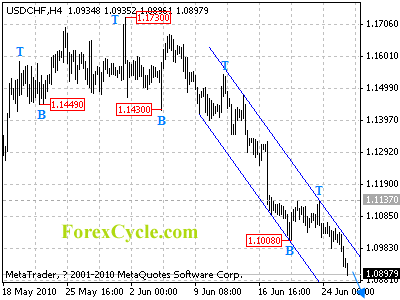Source: ForexYard
After a relatively calm trading week, an extremely volatile session is expected starting today. Last week, the Dollar fell against most of the majors as poor housing data weakened the greenback; however this could all change following the U.S. employment data which is expected on Friday. Traders are also advised to follow the ADP forecast which is expected on Wednesday, as it is considered to be a reliable forecast for the real result that will be published on Friday. Will the Dollar Erase last week’s losses?
Economic News
USD – Dollar Weakens As Data Shows Slowdown in Economic Recovery
The Dollar slid against most of the major currencies during last week’s trading session. The Dollar dropped about 400 pips against the Pound and about 200 pips against the Yen.
The Dollar dropped as data showed that the U.S. economy’s recovery might be progressing slower than expected. The Existing Home Sales dipped by 2.2% in May to 5.66M from 5.79M in April, failing to reach expectations for 6.17M. The housing sector suffered from another misfortune as the New Home Sales failed to reach expectations as well. The report showed that sales of new homes plunged to a record low. Merely 300,000 new homes were sold during in May, well below the 446,000 which were sold in April, and well below the expected 424,000.
The unsatisfying data continued as the Durable Goods Orders report was published. The report showed that durable goods orders fell in May for the first time in 6 months. The report indicated a 1.1% drop. Following about 2 months in which the Dollar strengthened against most of the major currencies, such disappointing publications were enough to correct some of the Dollar’s gains.
As for the week ahead, many interesting publications are expected from the U.S. economy. The economic release which is likely to have the greatest impact will be the Non-Farm Payrolls report, scheduled for Friday. The Non-Farm payrolls report is the most reliable data regarding the U.S. employment status. Analysts have forecasted that unemployment condition in the U.S. has worsened during June. If the actual result will be similar, the Dollar’s drop may deepen.
EUR – Euro Drops On Disappointing Data from the Euro-Zone
The Euro plunged against most of its major counterparts last week. The Euro saw mixed results against the Dollar, yet weakened against both the Pound and the Yen. The Euro dropped about 400 pips against the Yen, and the EUR/JPY pair fell to the 109.52 level.
The Euro’s slide came as a result of several disappointing economic publications from the Euro-Zone. The European Current Account, which measures the difference in value between imported and exported goods and services, showed a €5.1 billion deficit in April, swinging from a €1.5 billion surplus in March. In addition, the Belgium Business Climate survey, which asks about 6,000 businesses to rate their business conditions and expectations for the next 6 months, dropped for the 27th consecutive time. Another disappointing economic publication was the Industrial New Orders report. The report showed that European industrial new orders rose by 0.9%, yet failed to reach expectations of 1.6%.
Following the ongoing gloomy forecasts regarding the Euro-Zone’s future, it seems that until solid data will prove that the European economies are truly recovering, the Euro may continue to tumble against the major currencies.
As for this week, traders are advised to follow the major publications from the German economy, such as the German Preliminary Consumer Price Index and the German Unemployment Claims. If the end results will show further recovery of the German economy, which is the largest and strongest economy in the Euro-Zone, the Euro might correct some of its losses. Traders are also recommended to follow The European Central Bank (ECB) President Trichet’s speech on Wednesday. Trichet is likely to discuss the ECB’s future plans and policy, and large volatility is likely to take place during his speech.
JPY – Yen Soars as Risk Aversion Increases
The Yen strengthened against most of the major currencies during last week’s trading session. The Yen marked a 200 pips gain vs. the Dollar, and the USD/JPY pair is now trading near the 89.30 level. The Yen strengthened against the Euro as well.
The main reason for the Yen’s rise last week was the disappointing data from the Euro-Zone and especially the U.S. economy. In the U.S. the housing sector, which was the catalyst for the recent global crisis, provided rather disturbing figures. This created concerns that the U.S. recovery might take longer than expected, and as a result will damage global recovery as well. The Euro-Zone has provided various disappointing economic publications as well. All this has reduces risk-appetite in the market, and turned investors to look for safer assets. The Yen is considered to be a relatively safe investment, and thus when risk aversion increases, investors tend to put their faith in the Yen. As a result the Yen soared against most of its counterparts.
Looking ahead to this week, a batch of data is expected from the Japanese economy. The most significant publication looks to be the Tankan Manufacturing Index, which is expected on Wednesday. This is a survey of about 1,200 large manufacturers, which are asked to rate the relative level of general business conditions. Analysts have forecasted that the end result will be negative. If the actual result will indeed be negative, the Yen may erase some of its gains from last week.
Crude Oil – Crude Oil Reaches Above $79 a Barrel
Crude Oil saw an extremely volatile session during last week’s trading. Crude Oil began last week with a sharp drop of about 400 pips, and a barrel of Crude Oil was traded below $76. However by Friday oil saw a sharp rise and Crude Oil is now trading above $79 a barrel.
Oil prices rose Friday as rough whether in the Caribbean Sea threatened to progress into a hurricane in the Gulf of Mexico. This created speculations that Oil supply could be damaged, and energy prices jumped in response. However, currently it seems that the rough whether will not develop into a severe storm, and as a result Oil’s bullish trend has eased, and Crude Oil’s prices remain steady at around $79 a barrel.
As for this week, traders are advised to follow every development regarding the weather around the Gulf of Mexico, as every publication regarding the potential hurricane could boost Oil prices once again. Traders are also advised to follow the U.S. Crude Oil Inventories report which is expected on Wednesday, as this report tends to have an immediate impact on the market.
Technical News
EUR/USD
After its recent bullish run the pair may be seeing some downward correction today. The RSI for the pair is floating in the overbought territory on the hourly chart while a bearish cross is evident on the 4 hour chart’s Slow Stochastic. An impending bearish cross can also be seen on the hourly MACD. Going short for the day may be advised.
GBP/USD
The pair may be seeing a bearish correction today as the RSI for the pair is floating in the overbought territory on the hourly, 8 hour and daily charts. A bearish cross is evident on the 4 hour, 8 hour and daily charts’ Slow Stochastic. A bearish cross is also evident on the hourly MACD. Going short for the day may be advised.
USD/JPY
The pair may see some recovery today following its recent drop. A bullish cross is evident on the 4 hour MACD as well as the 8 hour and daily charts’ Slow Stochastic. The RSI for the pair is floating in the oversold territory on the daily and 8 hour charts. Traders may be advised to go long for the day.
USD/CHF
The pair may be seeing some upward correction today as a bullish cross is evident on the hourly MACD as well as the 4 hour, 8 hour and daily charts’ Slow Stochastic. The pair’s RSI is floating in the oversold territory on the 2 hour, 4 hour, 8 hour and daily RSI while a breach of the Lower Bollinger Band is evident on the daily chart, indicating an imminent upward movement. Going long for the day may be advised.
The Wild Card
AUD/NZD
A breach of the upper Bollinger Band is evident on the 2 hour chart while the RSI for the pair is floating in the overbought territory on the hourly chart, indicating an imminent downward correction. Furthermore a bearish cross is also seen on the hourly and 2 hour charts’ Slow Stochastic. Forex traders may be advised to go short for today.
Forex Market Analysis provided by Forex Yard.
© 2006 by FxYard Ltd
Disclaimer: Trading Foreign Exchange carries a high level of risk and may not be suitable for all investors. There is a possibility that you could sustain a loss of all of your investment and therefore you should not invest money that you cannot afford to lose. You should be aware of all the risks associated with Foreign Exchange trading.
 the U.S. dollar by -70,974 contracts after being net short the euro by -62,360 contracts the week before on June 15th. The net short euro positions follows a sharp decline on the June 15th report to -62,360 from a total of -111,945 on June 8th.
the U.S. dollar by -70,974 contracts after being net short the euro by -62,360 contracts the week before on June 15th. The net short euro positions follows a sharp decline on the June 15th report to -62,360 from a total of -111,945 on June 8th.

